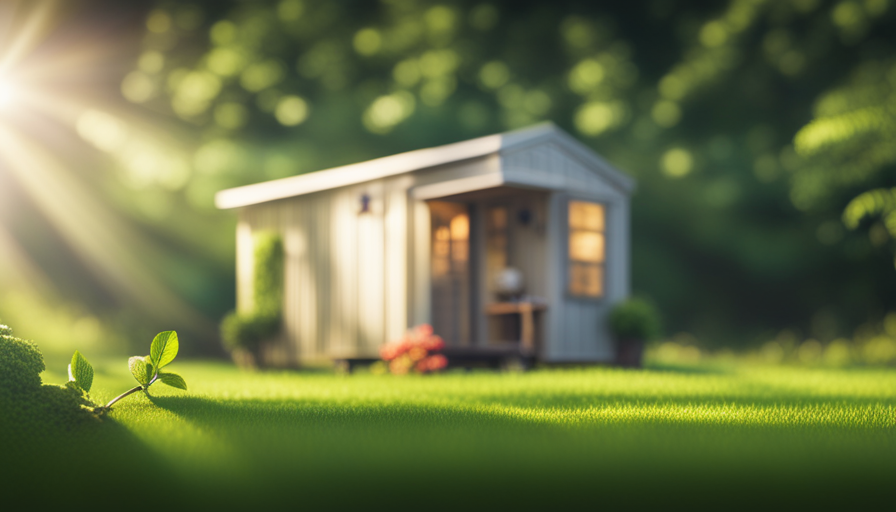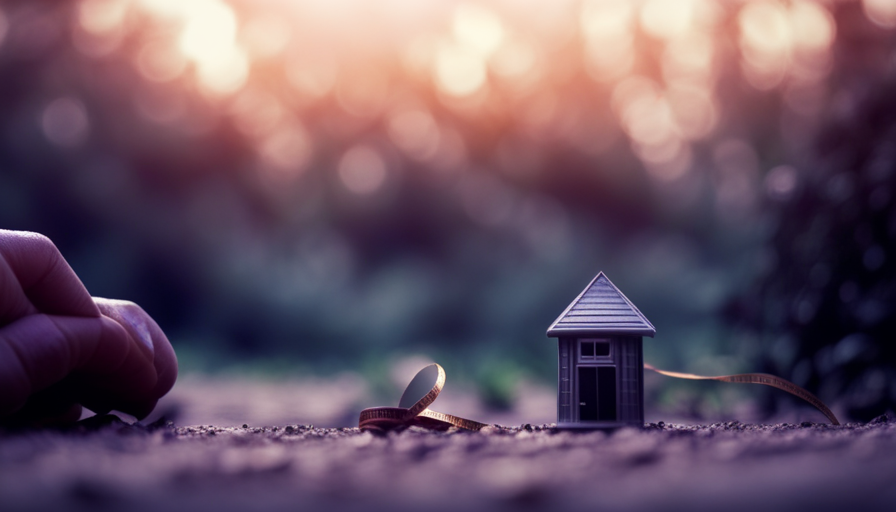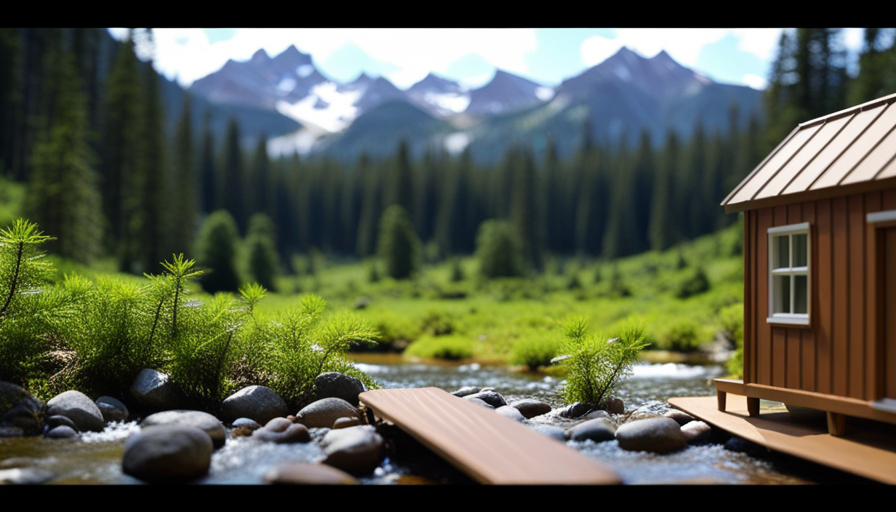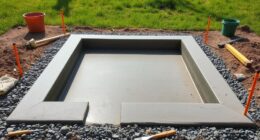As the saying goes, “Being cool is not just a state of mind, it’s also a science.” This holds true when it comes to air conditioning a small home. With limited space and unique requirements, it is essential to find the right balance in cooling capacity.
That’s where BTUs come into play. BTUs, or British Thermal Units, are a measurement of heat energy. In the realm of cooling, they indicate how much heat an air conditioner can remove from a space within an hour. Determining the ideal number of BTUs for your tiny house involves careful consideration of factors like size, layout, insulation levels, and even window placement.
In this article, we will delve into the world of BTUs and explore everything you need to know about cooling your tiny abode effectively. From assessing your specific needs to selecting the perfect air conditioner size and type, we’ll guide you through all the technicalities with precision.
So join me as we unravel this scientific puzzle and discover the best solutions for keeping your tiny house cool and comfortable all year round.
Key Takeaways
- Determining the ideal number of BTUs for a tiny house involves considering factors like size, layout, insulation levels, and window placement.
- Proper cooling with the right number of BTUs reduces humidity, improves air quality, and enhances energy efficiency.
- Evaluating square footage, insulation levels, windows, and doors helps determine BTU requirements.
- Choosing an air conditioner with a high EER or SEER rating saves energy.
Understanding BTUs and their significance in cooling a space
Do you know how many BTUs it takes to cool a tiny house? Understanding the significance of BTUs in cooling a space is crucial when it comes to assessing efficiency and understanding the benefits.
BTU, or British Thermal Unit, is a unit of measurement used to quantify the amount of heat energy needed to cool or heat a space. In the context of cooling, BTUs are used to measure the cooling capacity of air conditioners.
Assessing efficiency is important because it allows us to determine the most effective way to cool our tiny house without wasting energy. By understanding how many BTUs are required for our specific space, we can avoid purchasing an air conditioner that is either too small and struggles to effectively cool the area or too large and consumes unnecessary amounts of energy.
Moreover, knowing how many BTUs are needed helps us understand the benefits associated with proper cooling. A correctly sized air conditioner not only keeps our tiny house comfortable but also reduces humidity levels, improves indoor air quality, and enhances overall energy efficiency.
To assess the size and layout of your tiny house to determine BTU requirements, it’s essential to consider factors such as square footage, insulation levels, number of windows and doors, ceiling height, and local climate conditions. By taking these aspects into account, we can accurately determine the appropriate number of BTUs needed for efficient cooling.
Assessing the size and layout of your tiny house to determine BTU requirements
Assessing the size and layout of your cozy abode will help determine the appropriate amount of energy needed for optimal temperature control. When evaluating the space, it’s crucial to consider the square footage of each room in your tiny house. This will provide a baseline for calculating the BTU requirements necessary to cool your home effectively.
Additionally, take into account any open floor plans or high ceilings that may affect airflow and heat distribution.
Calculating the requirements involves multiplying the square footage by a factor specific to each type of room. For example, living rooms typically require 20 BTUs per square foot, while bedrooms may need only 10 BTUs per square foot. Keep in mind that insulation plays a significant role in maintaining desired temperatures, so be sure to assess its quality throughout your tiny house.
Furthermore, windows are another important factor that affects cooling needs. The number and size of windows can impact heat gain and loss significantly. Consider both their location and orientation when determining how much cooling power is required.
By carefully evaluating these aspects of your space and accurately calculating your BTU requirements, you can ensure efficient temperature control within your tiny house.
Transitioning into the next section about factors that affect cooling needs in a tiny house (such as insulation and windows), it’s vital to understand how these elements directly impact energy consumption and ultimately influence comfort levels without compromising efficiency.
Factors that affect cooling needs in a tiny house (insulation, windows, etc.)
Consider the quality of insulation and the size and location of windows when determining how to effectively control the temperature in your cozy abode. Insulation efficiency plays a crucial role in maintaining a comfortable indoor environment. It helps prevent heat transfer between the inside and outside of your tiny house, keeping it cool during hot weather. High-quality insulation materials such as spray foam or rigid foam boards with high R-values are recommended for optimal thermal performance.
Additionally, the size and location of windows can greatly affect cooling needs in a tiny house. Large windows allow more sunlight to enter, increasing heat gain during summer months. Installing low-emissivity (low-E) coatings on windows can help reduce solar heat gain while still allowing natural light into your space. Window shades or blinds also provide an effective way to block out direct sunlight during peak hours.
To further enhance cooling efficiency, proper ventilation options should be considered. This allows fresh air to circulate throughout your tiny house, reducing humidity and improving overall comfort. Ventilation options may include exhaust fans, window fans, or even a small ductless mini-split air conditioner with built-in ventilation capabilities.
Assessing insulation efficiency and considering window size and location are key factors in determining cooling needs for your tiny house. Proper ventilation options should also be taken into account to ensure optimal temperature control. Transitioning into the subsequent section about choosing the right air conditioner size and type for your tiny house requires careful consideration of these factors without compromising on comfort and energy efficiency.
Choosing the right air conditioner size and type for your tiny house
Ensuring optimal temperature control and maximum energy efficiency is crucial when selecting the ideal air conditioner for your cozy space. When it comes to cooling a tiny house, there are several factors to consider, including the size and type of air conditioner. To help you make an informed decision, here are some key points to keep in mind:
-
Energy-saving cooling options: Look for air conditioners that have a high Energy Efficiency Ratio (EER) or Seasonal Energy Efficiency Ratio (SEER). These ratings indicate how efficiently the unit uses electricity to cool your space.
-
DIY air conditioning installation: If you’re handy with tools and want to save money on installation costs, consider purchasing a window or portable air conditioner that you can install yourself. Just make sure it’s compatible with your tiny house’s windows and electrical system.
-
Proper sizing: It’s important to choose an air conditioner that is appropriately sized for your tiny house. A unit that’s too small will struggle to cool the space effectively, while one that’s too large will cycle on and off frequently, wasting energy.
-
Window vs. portable units: Window air conditioners are typically more efficient than portable ones since they vent hot air directly outside. However, if your tiny house doesn’t have suitable windows or if you want flexibility in moving the unit around, a portable option may be more suitable.
-
Noise level: Consider the noise level of the air conditioner before making a purchase. Since tiny houses have limited space, excessive noise from the unit could be bothersome.
By considering these factors and choosing the right size and type of air conditioner for your tiny house, you can ensure energy-efficient cooling options while maintaining optimal temperature control.
In the next section about "energy-efficient cooling options for tiny houses," we’ll explore additional strategies to keep your cozy haven comfortable without breaking the bank on electricity bills.
Energy-efficient cooling options for tiny houses
To maximize energy efficiency in your cozy space, you’ll want to explore the various options for cooling your tiny house. When it comes to energy-efficient cooling systems, there are a few options that can help keep your tiny house cool without consuming excessive power.
One option is to invest in a mini-split air conditioning system. These systems consist of an outdoor unit and one or more indoor units, allowing for individual temperature control in different areas of your tiny house. Mini-splits are known for their high energy efficiency ratings and can be a great choice for keeping your tiny house cool while minimizing electricity usage.
Another energy-efficient cooling option for tiny houses is solar-powered cooling systems. These systems use solar panels to generate electricity, which powers the air conditioner. By harnessing the sun’s energy, you can cool your tiny house without relying solely on the electrical grid.
Proper placement and installation of air conditioning units in a tiny house is crucial for optimal performance and energy efficiency. In the next section, we will discuss how to ensure that your air conditioning unit is placed correctly and installed properly to provide effective cooling while minimizing energy consumption.
[Transition: Now that we have explored energy-efficient cooling options, let’s move on to discussing the proper placement and installation of air conditioning units in a tiny house.]Proper placement and installation of air conditioning units in a tiny house
When it comes to keeping your cozy space comfortable, the placement and installation of your air conditioning unit in a tiny house is crucial for optimal performance and energy efficiency.
Proper placement considerations should be taken into account to ensure that the AC unit can effectively cool the entire space. First and foremost, choose an area with good airflow, away from obstructions such as furniture or curtains. This will allow for better circulation of cool air throughout the tiny house.
Additionally, it’s important to install the unit at a height that allows for easy maintenance and cleaning. Placing it too high may make it difficult to reach for filter changes or repairs. On the other hand, installing it too low could impede airflow and reduce its cooling capacity.
Furthermore, proper insulation around the AC unit is essential to prevent air leakage and maintain energy efficiency. Seal any gaps or cracks around the unit using weatherstripping or foam insulation tape.
When considering the placement and installation of your air conditioning unit in a tiny house, take into account factors such as airflow, accessibility for maintenance, and proper insulation. These tips will ensure that your AC performs optimally while keeping your cozy space cool and comfortable without relying solely on air conditioning.
Additional tips for keeping your tiny house cool without relying solely on air conditioning
When it comes to cooling a tiny house, proper placement and installation of air conditioning units are crucial. However, relying solely on air conditioning can be costly and inefficient. That’s why it’s important to consider additional tips for keeping your tiny house cool without overusing your AC.
One effective technique is implementing energy-saving techniques. This includes using energy-efficient appliances and insulation materials that help keep the interior temperature stable. Additionally, installing window coverings such as blinds or curtains can block out direct sunlight and reduce heat gain.
Another strategy is utilizing natural ventilation. Opening windows strategically to create cross ventilation can promote airflow and decrease the need for constant air conditioning usage. Installing ceiling fans or portable fans can also aid in circulating cool air throughout the space.
By incorporating these energy-saving techniques and maximizing natural ventilation, you can minimize your reliance on air conditioning while still maintaining a comfortable indoor temperature in your tiny house.
Now, let’s delve into maintenance and troubleshooting tips for your tiny house cooling system to ensure its optimal performance all year round.
Maintenance and troubleshooting tips for your tiny house cooling system
Ensuring optimal performance of your cooling system in a small space can be a breeze with these maintenance and troubleshooting tips.
-
Regularly clean and replace air filters: Dirty filters can restrict airflow, reducing the efficiency of your cooling system. Clean or replace filters every one to three months.
-
Check for refrigerant leaks: Low refrigerant levels can cause your cooling system to work harder and less efficiently. Inspect for any signs of leakage, such as oil stains or hissing sounds, and promptly repair any leaks.
-
Keep the condenser unit clear: Remove any debris, leaves, or obstructions from around the outdoor condenser unit to ensure proper airflow. This will help prevent overheating and improve overall performance.
-
Inspect ductwork for leaks: Leaky ducts can lead to cooled air escaping before it reaches its intended destination. Seal any visible leaks using mastic tape or other appropriate sealing materials.
-
Schedule regular professional maintenance: A qualified technician should inspect your cooling system annually to identify potential issues early on and keep it running smoothly.
By following these maintenance tips and addressing common issues promptly, you can maximize the efficiency of your tiny house cooling system.
Now, let’s delve into cost considerations and budget-friendly cooling solutions for tiny houses without missing a beat.
Cost considerations and budget-friendly cooling solutions for tiny houses
To keep your small space comfortable without breaking the bank, let’s explore cost-effective cooling options for your compact home.
When it comes to tiny house cooling, it’s important to consider both the initial cost and long-term energy savings. One cost-effective cooling solution is a window air conditioner. These units are generally more affordable compared to central air conditioning systems and can effectively cool a small space. Additionally, they consume less energy, resulting in lower utility bills.
Another budget-friendly option is a portable air conditioner. These units provide flexibility as they can be moved from room to room as needed. They also tend to be more energy-efficient than window units, offering potential long-term savings on electricity costs.
In addition to choosing the right type of cooling system, there are several energy-saving tips you can implement to further reduce costs. For example, sealing any air leaks around windows and doors will prevent cool air from escaping and hot air from entering your tiny house. Installing blinds or curtains can also help block out sunlight and reduce heat gain.
By considering these cost-effective cooling solutions and implementing energy-saving tips, you can create a comfortable living environment in your tiny house while keeping expenses under control.
As we delve into exploring alternative cooling methods for eco-friendly and sustainable living in a tiny house, it’s important to find solutions that align with your budget and environmental values without compromising comfort or convenience.
Exploring alternative cooling methods for eco-friendly and sustainable living in a tiny house
Implementing environmentally-conscious cooling techniques in a compact living space can enhance sustainability and foster an eco-friendly lifestyle. When it comes to tiny houses, traditional air conditioning units may not be the most ideal choice due to their energy consumption and high BTU requirements. However, there are several eco-friendly cooling options available that can effectively cool a tiny house while minimizing environmental impact.
One option is using passive cooling techniques, such as strategic window placement, insulation, and natural ventilation. By designing the tiny house with well-insulated walls and windows that allow for cross ventilation, heat gain can be reduced, making it easier to maintain a comfortable indoor temperature without relying heavily on air conditioning.
Another sustainable cooling method is utilizing evaporative coolers or swamp coolers. These systems work by drawing in warm outside air through moist pads or filters and blowing out cooler air into the living space. This process relies on evaporation to lower the temperature, consuming less energy compared to traditional air conditioners.
Additionally, incorporating green roofs or reflective roofing materials can help reduce heat absorption from sunlight, further reducing the need for artificial cooling methods.
Exploring eco-friendly cooling options in a tiny house promotes sustainable living by minimizing energy consumption and reducing environmental impact. Passive cooling techniques, evaporative coolers, and reflective roofing materials are just some of the options available for those seeking an environmentally-conscious approach to staying cool in their compact living space.
Frequently Asked Questions
Are there any eco-friendly and sustainable cooling methods for tiny houses?
Oh, eco-friendly and sustainable cooling methods for tiny houses? Well, let me enlighten you with my technical prowess.
When it comes to keeping your tiny house cool without harming the environment, there are several innovative options to consider.
From solar-powered air conditioners to passive cooling designs that maximize natural airflow, these sustainable cooling solutions are the epitome of efficiency.
So say goodbye to traditional energy-guzzling systems and embrace a cooler future with these eco-friendly alternatives.
What are some cost considerations and budget-friendly cooling solutions for tiny houses?
When considering cost and energy efficient options for cooling a tiny house, it’s important to explore budget-friendly solutions.
Some considerations include the initial purchase cost of the cooling system, as well as ongoing operational expenses such as electricity consumption.
Opting for energy-efficient cooling methods like mini-split air conditioners or evaporative coolers can help reduce costs in the long run.
Additionally, utilizing natural ventilation and insulation techniques can further enhance energy efficiency and minimize expenses.
Are there any additional tips for keeping a tiny house cool without relying solely on air conditioning?
When it comes to keeping a tiny house cool without relying solely on air conditioning, there are several tips and strategies that can be effective. By implementing proper insulation, using reflective window coverings, and strategically placing shade-providing plants or awnings outside the house, you can reduce heat gain significantly.
Additionally, utilizing natural ventilation techniques such as cross ventilation and opening windows during cooler hours can help maintain a comfortable indoor temperature. These cost-effective methods promote energy efficiency while ensuring a cool living space.
What are some maintenance and troubleshooting tips for a tiny house cooling system?
Maintenance tips for a tiny house cooling system include regularly cleaning the air filters to ensure proper airflow and efficiency. Additionally, checking the condenser unit for any debris or obstructions is crucial.
Troubleshooting techniques involve inspecting the thermostat settings and ensuring they’re correctly calibrated. Furthermore, examining the refrigerant levels and electrical connections can help identify potential issues.
Regular maintenance and troubleshooting will keep your cooling system running smoothly and extend its lifespan.
How do insulation and windows affect the cooling needs of a tiny house?
Insulation and windows play a crucial role in determining the cooling needs of a tiny house. According to a study conducted by the Department of Energy, proper insulation reduces energy consumption for cooling by up to 30%.
High-quality windows with low-emissivity coatings can also prevent heat transfer, further optimizing energy efficiency.
By implementing these energy efficient cooling methods, such as insulation and windows, one can significantly reduce the BTUs required to cool a tiny house effectively.
Conclusion
In conclusion, when determining the BTU requirements for cooling a tiny house, it’s crucial to consider factors such as insulation and window quality. Choosing the right air conditioner size and type is essential for efficient cooling.
Interestingly, according to a study by the U.S. Department of Energy, using energy-efficient cooling options in a tiny house can save up to 30% on energy costs compared to traditional systems. By implementing eco-friendly alternatives and following proper maintenance practices, you can create a comfortable and sustainable living environment in your tiny house.
Hi, I’m Emma. I’m the Editor in Chief of Tiny House 43, a blog all about tiny houses. While tree houses are often associated with childhood, they can be the perfect adult retreat. They offer a cozy space to relax and unwind, surrounded by nature. And since they’re typically built on stilts or raised platforms, they offer stunning views that traditional homes simply can’t match. If you’re looking for a unique and romantic getaway, a tree house tiny house might just be the perfect option.










